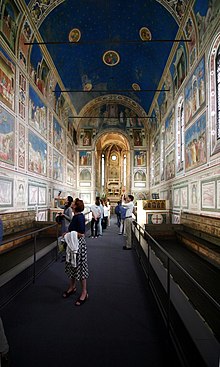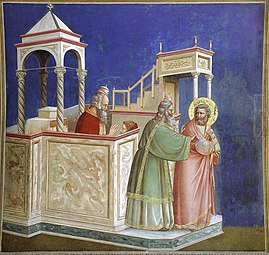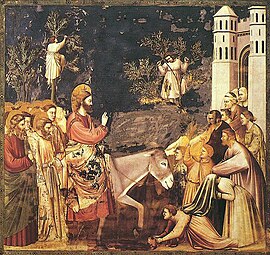Cappella degli Scrovegni
The Cappella degli Scrovegni (also called Scrovegni Chapel or Arena Chapel ) is a chapel in Padua , Veneto , in Italy , famous for the frescoes by Giotto di Bondone and sculptures by Giovanni Pisano .
History and architecture
On February 6, 1300, Enrico Scrovegni , a wealthy banker , merchant and nobleman from Padua , bought the dilapidated Roman amphitheater ( arena ) on the outskirts of Padua to build a family palace, which has now been destroyed, and allegedly also a chapel in memory of his father , the banker Rinaldo, to build. This Rinaldo Scrovegni appears in Dante Alighieri's Divine Comedy, banished to hell for usury . In fact, the chapel was primarily designed as a palace chapel and as the destination of a procession that took place every year on the Annunciation Festival and ended in the arena with a mystery play. Construction of the chapel began in 1302 after Bishop Ottobone di Razzi had given his approval. The Chapel of Our Lady of Charity was consecrated on the feast of the Annunciation on March 25, 1305 .
The side walls of the simple brick building are divided into six wall fields by flat pilaster strips .
The room of the chapel is 20.5 m × 8.5 m and 18.5 m high. The ceiling forms a barrel vault. Under a large arch is the narrow and deep apse in the east with a polygonal finish, ribbed vault and two high Gothic pointed arched windows . A large triple window with a Gothic pointed arch in the front wall and six high, single-arched side windows on the south side illuminate the room. Due to the fact that the painting was already taken into account in the planning phase, Giotto is also assumed to be an architect.
Artist
Enrico Scrovegni hired the greatest artists of his time to decorate the interior of the single-nave chapel. Giovanni Pisano turned around 1305-1306 three marble statues for the altar, the Holy Virgin Mary with Child and two candlesticks entertaining angels . From 1304 to 1306 Giotto di Bondone painted the walls and the vault of the chapel with 38 scenes from the life of Saints Joachim and Anna , their daughter Maria and the life of Jesus Christ . The fresco cycle is laid out in three registers, starting at the top right.
One scene from this cycle is the Adoration of the Magi , in which a comet hovers in the sky. Probably this is also one of the earliest depictions of Halley's Comet , which was visible to the naked eye in 1301.
Below the scenes on the life of Jesus on the side walls of the chapel there are the four cardinal virtues and the three theological virtues and seven vices opposing these virtues as allegorical representations. They are lined up in the direction of the Last Judgment , which is shown above the entrance portal, on the corresponding side of the saints or damned. Giotto used painted architectural elements that simulate niches for the viewer ( trompe-l'œil ) in which the figures are located. In between you can see painted marble that is deceptively real .
Above the entrance to the chancel , the triumphal arch that leads to the choir , God the Father is enthroned , commissioning the Archangel Gabriel to preach the conception of Jesus to the Virgin Mary. The Annunciation is shown below in two separate pictures along the entrance arch to the chancel . Mary is shown here with her head bowed and arms crossed in front of her chest, a sign of consent.
The picture above the altar itself is unfortunately destroyed, on the sides there are depictions of the death of the Blessed Virgin and her assumption into heaven . Behind the altar is the grave monument of Enrico Scrovegni made of white and red marble, which depicts him lying down. It was made by a sculptor known only as the master of the Scrovegni tomb . On both sides of the chancel a wooden's choir stalls attached. The crucifix painted by Giotto can be seen in the neighboring Musei Civici .
The vaults of the chancel and the main nave are probably painted with a blue starry sky based on the tomb of Galla Placidia in Ravenna . Within the vault of heaven there are representations of Jesus, the Blessed Virgin Mary with child and the prophets of the Old Testament. The upright sculpture of Enrico Scrovegni (around 1305) stands in the sacristy .
The chapel has been restored since the 19th and 20th centuries, as the frescoes were damaged by building and environmental damage. a. suffered badly during the bombing of Padua in World War II and by salt deposits. Only a limited number of visitors are allowed access for 15 minutes at a time.
- Fresco cycle
literature
- Eleonora M. Beck: Justice and Music in Giotto's Scrovegni Chapel Frescoes . In: Music in Art: International Journal for Music Iconography . 29, No. 1-2, 2004, ISSN 1522-7464 , pp. 38-51.
- Philippe Cordez: Les marbres de Giotto. Astrologie et naturalisme à la chapelle Scrovegni, communications from the Art History Institute in Florence , 45/1 (2013), p. 8-25, http://archiv.ub.uni-heidelberg.de/artdok/6166/1/Cordez_Les_marbres_de_Giotto_2013.pdf
- Walter Euler: The architectural representation in the arena chapel. Their significance for Giotto's image, Bern 1967
- Malafarina Gianfranco ed. La Capella degli Scrovegni a Padova (The Scrovegni Chapel in Padua) (Italian / English) Franco Cosimo Panini, Mirabilia Italiae Guide, 2005, ISBN 88-8290-764-3
- Jacqueline Guillaud: Giotto architect of colors and shapes; Fresco cycle of the arena chapel in Padua, Stuttgart 1988, ISBN 3-608-76241-8
- Max Imdahl: Giotto arena frescoes; Ikonographie, Ikonologie, Ikonik, Munich 1988, ISBN 3-608-76241-8
- Anna Maria Spiazzi: Giotto The Scrovegni Chapel in Padua, Skira, Geneva - Milan 2004, ISBN 978-8884918475
- James Stubblebine: Giotto: The Arena Chapel Frescoes , London 1969
- Hans Michael Thomas: Giotto's “Council of Redemption” in the arena chapel of Padua , Werl, Westphalia 1991.
- Michael Viktor Schwarz: Padua, its Arena and the Arena Chapel: a liturgical ensemble , in: Journal of the Warburg and Courtauld Institutes, Volume 10: 2010, pp. 39-64
- Michael Viktor Schwarz: Giottus Pictor II: Giottos Werke (employee: Michaela Zöschg), Böhlau, Vienna 2008
- Stefano Zuffi, Giotto. The Cappella degli Scrovegni , Skira, Milan 2012, ISBN 978-88-572-1640-9
- Giuliano Pisani, L'ispirazione filosofico-teologica nella sequence Vizi-Virtù della Cappella degli Scrovegni , “Bollettino del Museo Civico di Padova”, XCIII, 2004, Milano 2005, pp. 61-97 ( https://www.academia.edu/4102442/L_ispirazione_filosofico-teologica_nella_sequenza_Vizi-Virt%C3%B9_della_Cappella_degli_Scrovegni ).
- Giuliano Pisani, Terapia umana e divina nella Cappella degli Scrovegni , in "Il Governo delle cose", dir. Franco Cardini, Firenze, n.51, anno VI, 2006, pp. 97-106.
- Giuliano Pisani, L'iconologia di Cristo Giudice nella Cappella degli Scrovegni di Giotto , in “Bollettino del Museo Civico di Padova”, XCV, 2006, pp. 45-65 ( https://www.academia.edu/4162139/Liconologia_di_Cristo_Giudice_nella_Cappella_degli_Scrovegni ).
- Giuliano Pisani, Le allegorie della sovrapporta laterale d'accesso alla Cappella degli Scrovegni di Giotto , in “Bollettino del Museo Civico di Padova”, XCV, 2006, pp. 67-77.
- Giuliano Pisani, Il miracolo della Cappella degli Scrovegni di Giotto , in Modernitas - Festival della modernità (Milano 22-25 giugno 2006), Spirali, Milano 2006, pp. 329-57.
- Giuliano Pisani, Una nuova interpretazione del ciclo giottesco agli Scrovegni , in “Padova e il suo territorio”, XXII, 125, 2007, pp.4–8.
- Giuliano Pisani, I volti segreti di Giotto. Le rivelazioni della Cappella degli Scrovegni , Rizzoli, Milano 2008, pp. 1-366. ISBN 978-88-17-02722-9 ; Editoriale Programma, Treviso, 2015, pp. 1-366 ISBN 978-88-6643-353-8 .
- Giuliano Pisani, Il programma della Cappella degli Scrovegni , in Giotto e il Trecento , catalogo a cura di A. Tomei, Skira, Milano 2009, I - I saggi, pp. 113–127 ( https://www.academia.edu/6608705/Giotto._Il_programma_della_Cappella_degli_Scrovegni ).
- Giuliano Pisani, La fonte agostiniana della figura allegorica femminile sopra la porta palaziale della Cappella degli Scrovegni , in “Bollettino del Museo Civico di Padova”, XCIX, 2010 (2014), pp. 35-46 ( https://www.academia.edu/5178881/La_fonte_agostiniana_della_figura_allegorica_femminile_sopra_la_porta_palaziale_della_Cappella_degli_Scrovegni ).
- Giuliano Pisani, La concezione agostiniana del programma teologico della Cappella degli Scrovegni , in Alberto da Padova e la cultura degli Agostiniani, a cura di F. Bottin, Padova University Press, Padova 2014, pp. 215-268 ( https://www.academia.edu/11613902/La_concezione_agostiniana_del_programma_teologico_della_Cappella_degli_Scrovegni ).
- Giuliano Pisani, Il capolavoro di Giotto. La Cappella degli Scrovegni , Editoriale Programma, Treviso, 2015, pp. 1–176 ISBN 978-88-6643-350-7 ( https://www.academia.edu/24989584/Il_capolavoro_di_Giotto._La_Cappella_degli_Scrovegni )
Web links
- Description of the chapel in English and Italian
- Virtual visit of the Cappella degli Scrovegni in Italian
- private photo gallery
- private album on Flickr
- venetocultura.org
Individual evidence
- ↑ Michael Viktor Schwarz, Padua, its Arena and the Arena Chapel: a liturgical ensemble , in: Journal of the Warburg and Courtauld Institutes , Volume 10: 2010, pp. 39-64.
- ↑ a b Spiazzi: Giotto The Scrovegni Chapel in Padua 2004, p. 13
- ↑ Volker Herzner: Giottos Grabmal für Enrico Scrovegni , in: Münchener Jahrbuch der bildenden Kunst, 33, 1982, pp. 39–66. See also: Volker Herzner: On the statue of Enrico Scrovegni, in Kunstchronik 2010, pp. 172–175
Coordinates: 45 ° 24 '42 " N , 11 ° 52' 46" E














